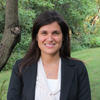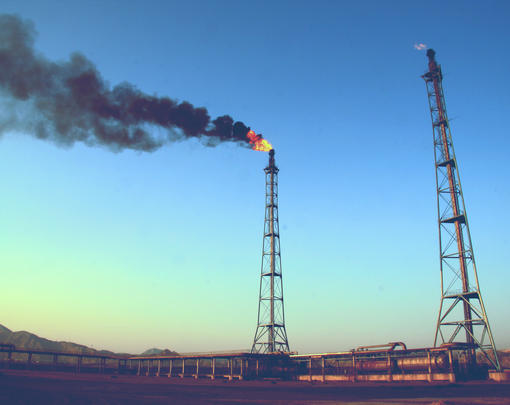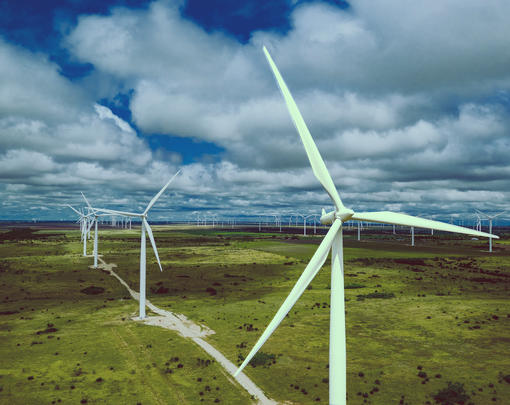Leveraging anchor institutions’ power to build a local, sustainable, and inclusive energy system
While many cities and communities rely on a “smokestack chasing” approach to economic development, others are starting to focus on a new approach to economic development that centers people and place. Instead of measuring growth by just revenue, this approach, coined “community wealth-building,” strengthens the local economy through broader democratic ownership and control of business and jobs.1 Rather than relying on (foreign) corporations to bring economic development to a region, community wealth building works to cultivate existing, local assets. Often, this includes working with anchor institutions, public and nonprofit entities rooted in place, such as hospitals, universities, cultural organizations, and local governments.2 It can be a night and day difference. As PolicyLink’s Tracey Ross explains, “General Motors in Flint, Michigan, picked up and left. And with it went all of these jobs, and that really decimated the economy. Wayne State University in Detroit? They’re not going to be picking up and leaving.”3
These large and economically vital entities are often driven by a broader mission than maximizing profits. For example, a non-profit or public hospital’s main goal is to promote long-term health and well-being in the communities it serves. Similarly, most universities aim to provide education to foster people’s productive and civic capacities. Given their social missions, invested capital, and relationships to customers, employees, and vendors, these institutions are rooted in communities for the long run, and as such, don’t have the same knee-jerk reaction as for-profit industries to fluctuating economic conditions. What’s more, they often have a responsibility to their community as custodians of significant public resources in the form of tax exemptions or, in the case of public universities and hospitals, government grants.
Anchor institutions’ jobs, capital, and stature translate into enormous power and influence—features that also elevate them to potential agents of systemic change. Defined as adopting the “anchor mission,” anchors can intentionally apply their place-based economic power and human capital, in partnership with community, for the long-term wellbeing and mutual benefit of both.4 In the coming energy transformation, anchors have the opportunity to leverage their power and influence to accelerate the creation of an energy system that can both mitigate climate change and build community wealth—all while bringing them closer to their institutional missions.
Aligning Anchors’ Power to Meet Energy Challenges
Whether climate action is written into their mission statements or not, anchor institutions’ goals and very existence depend on making energy systems work so as to mitigate climate change impacts. Take health, for example. Climate change affects basic determinants of health such as clean air and drinking water or access to food and shelter,5 and it also exacerbates health inequalities due to the disproportionate exposure of poorer people to toxins, extreme weather events, and other assaults.6 If the last hurricane season is any indication of what the future might look like, healthcare institutions will face one extreme public health crisis after another from now on. For instance, six months after Hurricane Maria made landfall, Puerto Rico saw “increases in incidences of cardiac arrests and intracranial hemorrhages, higher rates of waterborne disease, mushrooming suicides, and medical equipment and staff shortages.”7 The droughts hitting the US Midwest are also taking a toll on health. By compromising the quantity and quality of drinking water and food, increasing heat levels, and degrading air quality, affected areas are seeing a rise in levels of anxiety, mosquito-borne diseases, and heat exhaustion.8
Although less obvious, the same holds true for education. Along with curriculum quality and teacher expertise, education’s success depends on many other factors, such as safe school building conditions and student health. When hurricanes, thousand-year floods, or sea level rise force campuses to shut down, the disruptions can stymie or permanently damage human learning development.9 Consider Hurricane Katrina’s long-lasting effects on Louisiana with “one-third of Katrina’s displaced children […] at least one year behind in school for their age,” five years after the Hurricane made its landfall in 2005. This is believed to contribute to New Orleans’s having the nation’s highest rate of young adults not in school or working, fueling the region’s surging need for job training programs.10
Despite the rising threats of climate change to their mission and the communities they serve, anchor institutions themselves contribute to the climate problem through their large carbon footprints. In 2013, healthcare systems accounted for an estimated 10 percent of total greenhouse gas emissions in US.11 If healthcare institutions stay on this carbon-intensive path, they could be responsible for as much as 381,000 years of healthy life loss (“disability-adjusted life years” in scientific terms) annually worldwide.12
Several anchors have already recognized the carbon footprint challenge and taken steps to green their operations, from switching to efficient light bulbs to procuring more local goods. Some anchors have gone even further and committed to divesting from fossil fuel projects or adopting climate action plans. Such actions are important steps in the right direction, but the magnitude of the climate problem means we need to go beyond standard approaches and beyond these institutions’ own doors. Moving forward, anchors should embrace their social missions and their unique ability as knowledge centers to shape a new energy future. These community pillars should home-grow strategies and interventions that create and preserve environmental sustainability while enhancing local democracy and equity over the long-term, on and off campus.
Three Strategies to Leverage Anchors’ Role as Agents of System Change
The following sections outline three major leverage points for anchors in facilitating a sustainable and inclusive energy system: building the new grid, fostering a just transition for workers, and convening financial capacity.
Building the New Grid: Community Renewable Energy, Energy Efficiency and Microgrids
Anchor institutions can and should do more than mitigate their own carbon footprints. They can be leaders and exemplars in building renewable energy resources to promote climate benefits and empower local communities. Access to renewable energy is not evenly distributed in the US. For instance, close to 51 percent of people in the country lack access to solar because they rent their housing, can’t cover the upfront costs, or live in locations with poor conditions to generate power.13 Decentralized renewable energy can be particularly prohibitive for lower income households without the credit history or upfront cash needed to participate. Passing these households over would only widen the current gap between them and more affluent households and organizations able to make the upfront investment to reduce their long-term energy costs.14 Anchors can tap their immense resources—investments, procurement capacity, land and facilities, technical expertise, convening power, etc.—to help build community projects, and energy efficiency initiatives, that close this gap.
Community Renewable Energy and Energy Efficiency
Anchors can catalyze community renewable energy by advancing projects that not only supply their own campuses but also serve their communities, specifically low-income residents. By fronting the initial capital and initiating feasibility studies, developing equitable siting strategies, and leading third-party tenders for renewable projects, as well as facilitating community engagement along each step of the way, anchors can help to streamline large-scale community renewable energy projects on their own land or an underutilized local space, such as a brownfield site. Acting as “anchor tenants,” anchors can take on most of the cost and risk associated with a renewable project (for instance, 70 percent of the costs and of the solar panels) and allocate the rest of the energy shares to low-income residents.15 Similarly, anchors can play a crucial role in overcoming financial barriers faced by low-income residents and residents of color, whose credit scores average lower than white, high-income residents in part due to historical redlining policies.16 To quell energy developers’ fear of low-income residents defaulting on energy project’s payments, anchors can take advantage of their good credit and significant investment in the project as “financial fiduciaries,” and also promise to subscribe to more if the lower-income customers default.17 To further help the low-income subscribers, anchors could lower the financial barrier to initial ownership by working alongside developers to create pay-as-you-go options, such as on-bill financing, which require no upfront investments.18
Anchor institutions could make similar strides in energy efficiency programs, particularly for low-income community members. By investing in energy efficiency, particularly at affordable housing sites, anchor institutions can limit emissions in their communities and increase the safety and well-being of tenants. The Bronx Healthy Buildings Program is a perfect example. Created by the grassroots Northwest Bronx Community and Clergy Coalition (NWBCCC), in partnership with local hospitals, a university team, and the municipal government, the program aims to tackle the social determinants of health that trigger medical problems, like poor housing conditions and costly energy bills that often take away people’s income from other basic necessities.19 To address these determinants, the Bronx Health Buildings Program leverages participant anchors’ power to promote “education, organizing, workforce development, and building upgrades,” pinpointing specific buildings that are “drivers for high rates of emergency room visits.”20 The program then supports building inspections and tenant organizing to identify how to best implement energy efficiency improvements.21
Maintaining Microgrids
Anchors could also host microgrids—electrical subsystems designed to bring together local generation, storage, and distribution in a unified and coordinated way. Microgrids connect to the main grid to receive energy generated elsewhere or to send back excess energy generated locally. They can also operate in “island mode,” disconnected from the larger grid—which can be critical infrastructure when pieces of the main grid fail elsewhere. The integration of energy-storage capabilities at the microgrid level can help the grid with demand response and load management too, and increase local energy resilience.22
As large energy producers, anchors are ideal hubs for microgrids. They have the internal capacity to manage the microgrids for efficiency. They are power centers during outages, and many already have the physical infrastructure already in place. In the wake of Hurricane Irene, the City of Rutland, Vermont and its residents worked with the utility, Green Mountain Power, to implement a microgrid structure.23 The result: a 2.5-MW solar array consisting of 7,700 solar panels and 4 MW of storage capacity built at the city’s old dump. This project powers around 2,000 Rutland homes, and if disaster strikes again the array can be switch to island mode and supply power to the Rutland City High School, the area’s designated public emergency shelter.24
But there is a risk associated with microgrids. To the extent that large institutions and wealthier communities can peel off pieces of the grid, other communities may be left behind in a kind of piecemeal privatization. To keep this scenario from unfolding, anchor institutions must convene conversations around microgrid deployment to keep communities and local stakeholders at the table and honor principles of universal, equitable access. Anchors can work alongside the local community to build plans for a microgrid together, figuring out how to integrate renewable and battery assets, designing plans for disaster relief, and creating community energy efficiency—all key to ensure they succeed in their broader social mission.
Building a Labor Force for a New Energy Economy
Anchor institutions have many ways to leverage their power to develop a workforce for the new energy economy. The most obvious, especially for large institutions, is to use their purchasing power to generate a substantial number of new energy jobs locally. When implementing renewable energy, energy efficiency, and microgrid projects, anchor institutions can prioritize contracts with local vendors, including worker cooperatives or organizations with fair labor practices, enabling pathways for employment for local residents. Anchoring renewable energy development with local and community enterprises would make it hard for an extractive renewable energy sector to take hold, and would instead lift up workplaces in alignment with a local, sustainable, and inclusive system.
Besides procuring energy services from organizations with high-road business practices, anchor institutions can use their resources to prepare residents for green jobs or transition fossil fuel workers into new careers. As reported in the latest Solar Jobs Census, the solar workforce has increased by an astonishing 168 percent in last seven years—employing over 250,000 people in 2017.25 The result: the solar industry currently employs more workers than the coal industry (from mining to generation) and almost as many workers as the natural gas industry.26 And the renewable energy sector will need to grow even more. Getting serious about mitigating climate change—and bringing renewable energy from a mere 11 to 100 percent—means hiring tens of thousands more new and retrained workers to serve the transition.
Universities, community colleges, and other higher education institutions have a mission-minded role to play in developing a prepared workforce and lifelong civic learners. Instead of prepping students for jobs that should no longer exist, such as a petroleum or coal mining engineers, these institutions should equip students for upcoming jobs in such burgeoning fields as solar energy and efficiency deployment by increasingly centering curriculum on a new energy and sustainable economic model.
Post-secondary schools should also commit to the just transition. For starters, they could host low- to no-cost training centers for fossil fuel workers, underemployed workers, returning citizens, and low-income residents. Universities in New York State have been working with The New York State Energy Research and Development Authority since 2010 to advance local green jobs, partly through partnership programs ranging from entry-level apprenticeships and internships to incremental certification and on-the-job training.27
Although universities and community colleges are a clear fit for transitioning the new and current workforce, other anchor institutions can engage in this area too. Some already do—the Bronx Healthy Buildings program mentioned earlier has a robust training component that recruits and trains workers from the neighborhood to provide educational information to area tenants and landlords.28
Convening Financial Capacity
Anchor institutions can also play a key role in consolidating financial capacity to help overcome some of the numerous—and onerous—financial obstacles that keep lower-income people from competing with wealthy individuals and corporations for ownership opportunities in the energy transition. As addressed in previous sections, using portions of their discretionary funding to cover the upfront costs of a community renewable energy project would provide community members and low-income residents’ access to lending services and other financial incentives. Anchors can also set examples in their communities, using their projects as visible and inclusive educational tools that invite broad participation in the renewable economy. Specifically, they could help churches, public schools, or other community-based institutions with a significant carbon footprint deploy renewable power. A great example of this strategy is Solar Holler, which has connected West Virginia’s non-profits to financing programs for solar projects in highly visible community institutions like churches in Appalachian coal country, jumpstarting high levels of support and demand for renewables.29
Anchors also have invested assets, including endowments, that could advance energy democracy. Combined, US universities and healthcare systems hold investment portfolios nearing $1 trillion.30 Most of these institutions still have fossil fuel development projects in their investment portfolios. Anchors should divest from “brown” assets and invest in projects that align with their mission, including local green or renewable businesses. Specifically, anchors could leverage their assets to invest through community development financial institutions (CDFIs) targeting renewable or efficiency projects, increasing access to low-interest loan financing for projects. Besides setting these projects on a trajectory toward inclusive economic development from the get-go, this approach challenges traditional lenders and investors’ misconceptions about non-extractive, community-owned, and locally-based projects’ values and risks.
Conclusion: Calling All Anchor Institutions
In the past couple decades, anchor institutions have increasingly recognized the systemic aspects of fulfilling their social mission and started greening their activities to mitigate the rising threats climate change poses to their goals. Moving forward, anchors can position themselves as agents of change by leveraging their power and resources away from the extractive economy and into a new energy system—one aligned with their social mission of promoting people and communities’ health and well-being. While anchor institutions will have to tackle the climate crisis’ many dimensions—from water management to waste streams—one of the most pressing systemic climate issues is how we source our energy. Here we presented three strategies—building the new grid, fostering a just transition for workers, and convening financial capacity—for anchors to activate in the transition toward a regenerative energy system that builds community wealth.
- 1 For more information about community wealth building, see: Marjorie Kelly and Sarah McKinley, “Cities Building Community Wealth,” The Democracy Collaborative, 2015, https://democracycollaborative.org/cities.
- 2 “Overview: Anchor Institutions,” Community-wealth.org, accessed July 26, 2018, https://community-wealth.org/strategies/panel/anchors/index.html.
- 3 Tanvi Misra, “How Anchor Institutions Like Hospitals and Universities Can Help Cities,” CityLab, November 1, 2014, accessed July 26, 2018, https://www.citylab.com/solutions/2014/11/universities-and-hospitals-are-the-new-anchor-institutions-for-cities/382110/.
- 4 Adapted from definition established in: Steve Dubb, Sarah McKinley, and Ted Howard, “The Anchor Dashboard: Aligning Institutional Practice to Meet Low-Income Community Needs,” The Democracy Collaborative, August 2013.
- 5 “Climate change and health,” World Health Organization, February 1, 2018, accessed July 26, 2018, http://www.who.int/en/news-room/fact-sheets/detail/climate-change-and-health.
- 6 Janet Gamble et al., “Ch. 9: Population of Concern” in “The Impacts of Climate Change on Human Health in the United States: a Scientific Assessment,” US Global Change Research Program, 2016.
- 7 Mekela Panditharatne, “Six Months After Maria: Puerto Rico’s Growing Health Crisis,” Natural Resources Defense Council, March 21, 2018, accessed July 26, 2018, https://www.nrdc.org/experts/mekela-panditharatne/six-months-after-maria-puerto-ricos-growing-health-crisis.
- 8 “Drought and Public Health in the US,” Centers for Disease Control and Prevention, accessed July 26, 2018, https://www.cdc.gov/nceh/hsb/cwh/hsb_drought_infographic508-cleared.pdf.
- 9 Perry E Sheffield et al., “Climate Change and Schools: Environmental Hazards and Resiliency,” International Journal of Environmental Research and Public Health, Vol 14, No 11, 2018, https://www.ncbi.nlm.nih.gov/pmc/articles/PMC5708036/.
- 10 Katy Reckdahl, “The Lost Children of Katrina,” The Atlantic, April 2, 2015, accessed July 26, 2018, https://www.theatlantic.com/education/archive/2015/04/the-lost-children-of-katrina/389345/.
- 11 Nicole Wetsman, “Hospitals are helping make us all sick,” Popular Science, November 6, 2017, accessed July 26, 2018, https://www.popsci.com/hospital-emissions-climate-change#page-2.
- 12 Matthew J. Eckelman and Jodi D. Sherman, “Estimated Global Disease Burden From US Health Care Sector Greenhouse Gas Emissions,” American Journal of Public Health, Vol. 108, No. S2, 2018, https://ajph.aphapublications.org/doi/pdf/10.2105/AJPH.2017.303846.
- 13 John Farrell, “Beyond Sharing: How Communities Can Take Ownership of Renewable Power,” Institute for Local Self-Reliance, 2016, https://ilsr.org/report-beyond-sharing/.
- 14 Jocelyn Durkay and Megan Cleveland, “State policies for low- and moderate-income costumer access to renewable energy and energy efficiency,” National Conference of State Legislatures, November 16, 2016, accessed July 26, 2018, http://www.ncsl.org/research/energy/state-policies-for-low-income-and-moderate-income-customer-access-to-renewable-energy-efficiency.aspx.
- 15 For definition of “Anchor Tenant,” see: Jenny Solar, “Community Solar Anchor Tenant and Sponsor—Simply Explained,” Solar by CIR, January 21, 2016, accessed July 26, 2018, http://www.solarbycir.com/community-solar-anchor-tenant-and-sponsor-simply-explained/.
- 16 Sarah Ludwig, “Credit Scores in America Perpetuate Racial Injustice. Here’s How,” The Guardian, October 13, 2015, https://www.theguardian.com/commentisfree/2015/oct/13/your-credit-score-is-racist-heres-why.
- 17 Julian Spector, “How to Fix Solar Power’s Inequality Problem,” CityLab, March 11, 2016, accessed July 26, 2018, https://www.citylab.com/life/2016/03/shared-renewable-energy-community-solar-low-income-families-inequality/473103/.
- 18 For a description of on-bill financing, see: “On-Bill Financing and Repayment Programs,” Energy.gov, accessed July 26, 2018, https://www.energy.gov/eere/slsc/bill-financing-and-repayment-programs.
- 19 Jennifer Hiser, “The Bronx Health Buildings Program: Tackling Asthma, Creating High-Road Jobs,” Climate Co-Lab Radio, August 17, 2015, accessed July 27, 2018, http://colabradio.mit.edu/the-bronx-healthy-buildings-program-tackling-asthma-creating-high-road-jobs/.
- 20 Ibid.
- 21 “About The Bronx Healthy Buildings Program,” The Build Health Challenge, accessed July 27, 2018, http://buildhealthchallenge.org/communities/awardee-bronx-nyc/.
- 22 “How Microgrids Work,” Energy.gov, June 17, 2014, accessed July 26, 2018, https://www.energy.gov/articles/how-microgrids-work.
- 23 “Stafford Hill Solar Farm and Microgrid,” Clean Energy Group, accessed July 26, 2018, https://www.cleanegroup.org/ceg-projects/resilient-power-project/featured-installations/stafford-hill/.
- 24 Mike Breslin, “Unique Microgrid to Provide Vermont Town with Resilient Power,” Electrical Contractor Magazine, October, 2014, accessed July 26, 2018 https://www.ecmag.com/section/your-business/unique-microgrid-provide-vermont-town-resilient-power.
- 25 “National Solar Job Census,” The Solar Foundation, accessed July 26, 2018, https://www.thesolarfoundation.org/national/.
- 26 Christian Roselund, “More US jobs in solar than coal and nuclear combined,” PV Magazine, May 17, 2018, accessed July 16, 2018, https://pv-magazine-usa.com/2018/05/17/more-u-s-jobs-in-solar-than-coal-and-nuclear-combined/.
- 27 “Green Jobs—Green New York, Annual Report,” New York State Research and Development, 2012, http://www.pushgreenwny.org/Websites/pushgreen/images/2012-GJGNY-Annual-Report.pdf.
- 28 “Bronx Healthy Building Program Awarded $250,000 to Improve Community Housing, Reduce Asthma Hospitalizations and Create Green Jobs,” Montefiore, June 1, 2015, accessed July 26, 2018, http://www.montefiore.org/body.cfm?id=1738&action=detail&ref=1236.
- 29 “Repowering Appalachia with Hometown Energy,” Solar Holler, accessed July 26, 2018, http://www.solarholler.com/.
- 30 Investible assets calculation of $500 billion in healthcare investible assets, based on percentages in: Hazel Bradford, “Non-profits put investible assets under microscope,” Pensions & Investments, March 19, 2012, accessed July 26, 2018, http://www.pionline.com/article/20120319/PRINT/303199977/non-profits-put-investibleassets-under-microscope; and $566 billion in university endowments, calculated in: “Educational Endowments Report Decline in 10-Year Return Despite 12.2% Return for FY2017, Up Significantly from -1.9% Reported for FY20,” Commonfund Institute, January 15, 2018, https://www.commonfund.org/wp-content/uploads/2018/0½017-NCSE-Press-Release-FINAL-IMMEDIATE-RELEASE.pdf.






